Traditional English Crumpets
This post may contain affiliate links. See my disclosure policy.
Crispy, chewy and delicately spongy in texture with a delicious depth of yeasty flavor, look no further for the best and most authentic crumpets recipe! Serve these homemade crumpets with fruit preserves, marmalade, honey, or just slather on the butter and you’re all set for enjoying one of Great Britain’s most iconic foods!
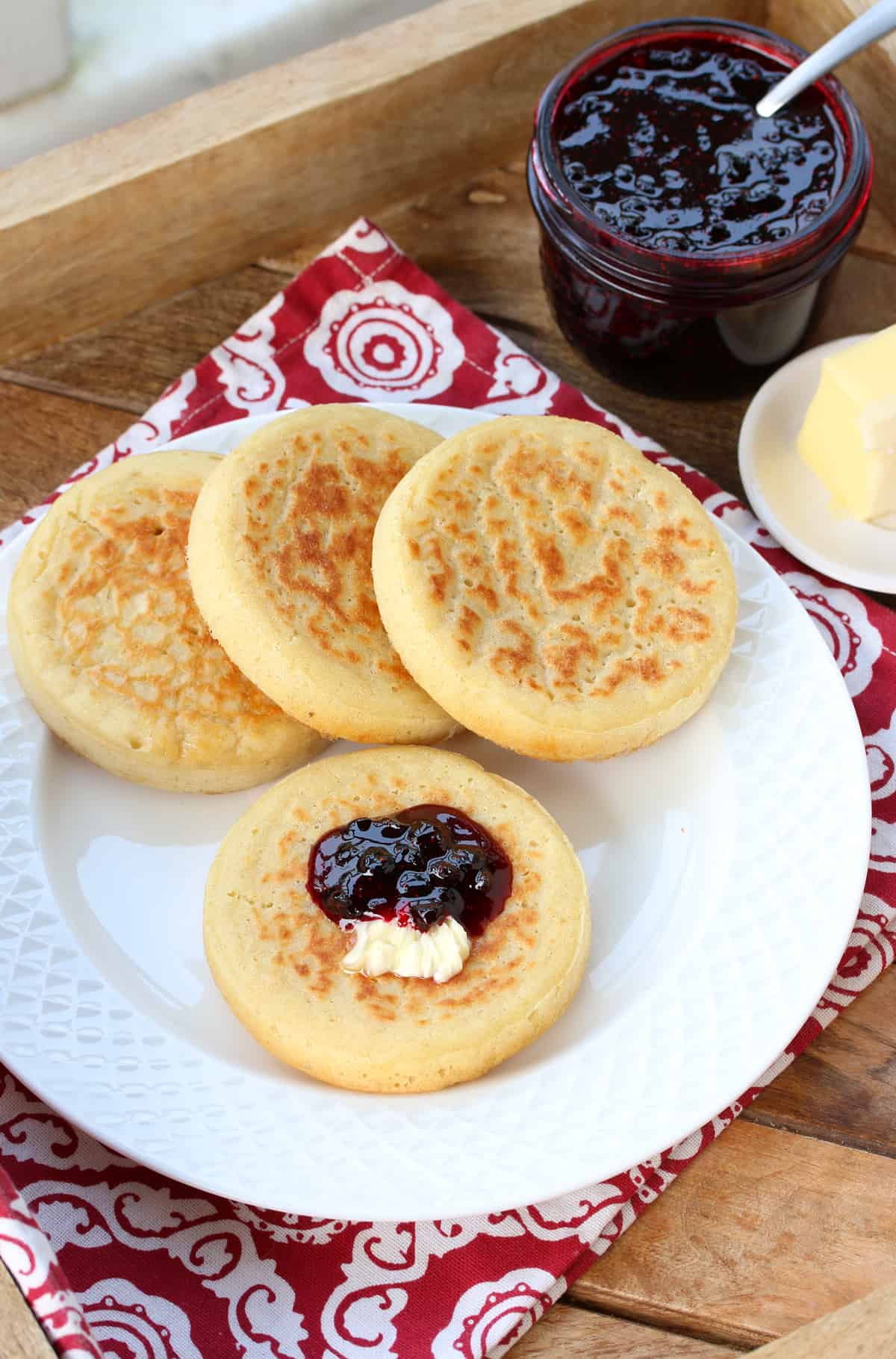
Homemade Crumpets
When I moved to England where I lived for 7 years, there were a number of quintessential British dishes I was eager to try. Crumpets was one of them. We had no sooner settled into our hotel room than we went grocery shopping at the local Tesco and I picked up a package of them for the following morning. We popped the them in the toaster, slathered them with butter and jam and took our first bite of English crumpets.
The verdict: The butter and jam were good. Excessively spongy in texture and bland in flavor, I wondered why, of all things, crumpets had earned such a prominent place on the British table. I swiftly wrote crumpets off as “tried them once and once was enough.”
….That is, until I ate some homemade crumpets at a friend’s house. My opinion of the famous crumpet made a 180 degree turn! Simultaneously crispy, chewy and delicately spongy in texture with a wonderful depth of yeasty flavor, I can promise you – homemade crumpets are everything they’re chalked up to be! Continue below to our crumpet recipe learn how to make the BEST homemade crumpets EVER!
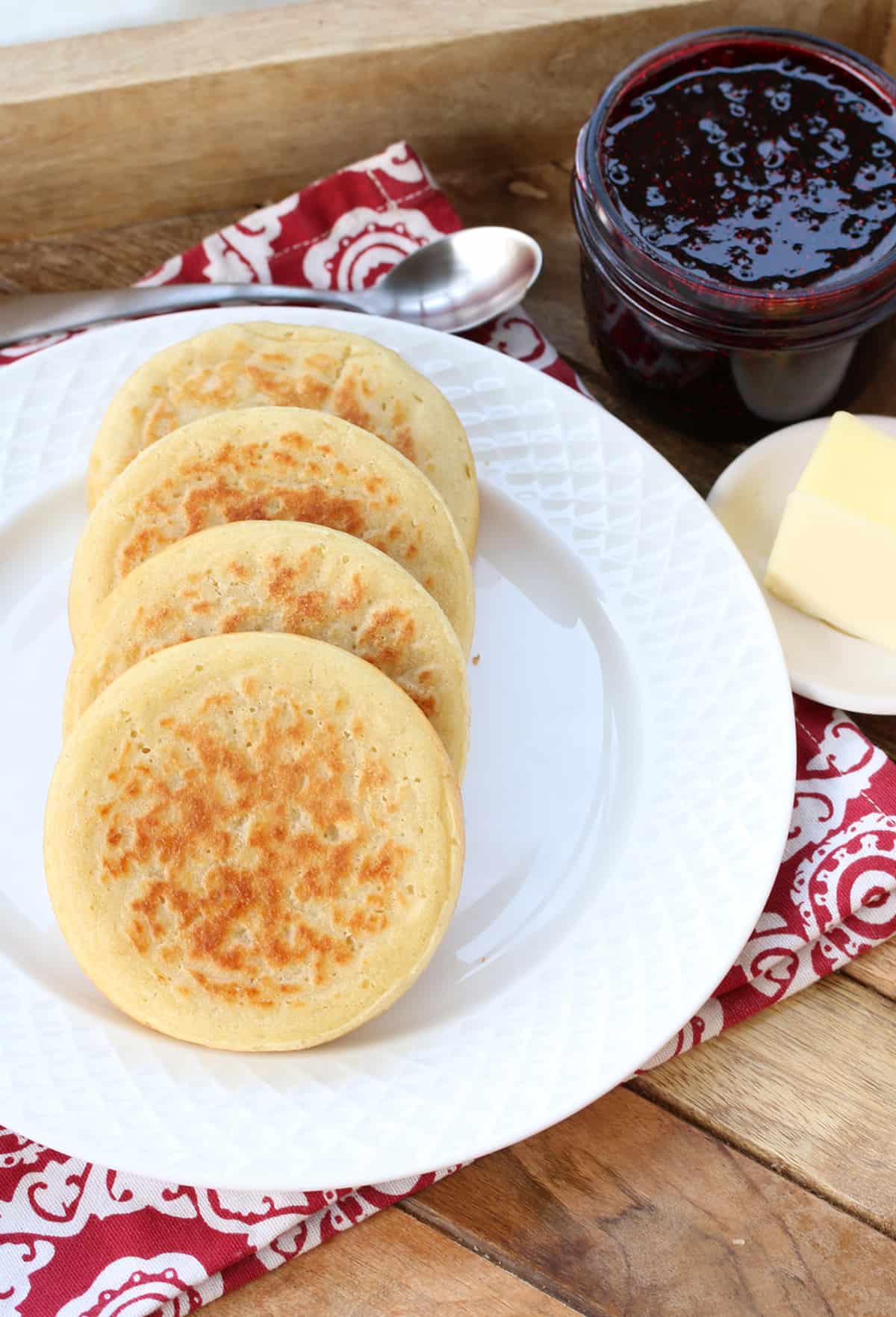
What is a Crumpet?
A crumpets is an English griddle cake made from flour, milk/water and yeast and is traditionally eaten for breakfast or with afternoon tea. Crumpets are soft and somewhat spongy in texture and their crowning feature are the dozens of tiny holes that dot the surface, allowing whatever you spread on them to soak down into them, making each and every bite an unforgettable one.
Where Did They Originate?
Crumpets originated in United Kingdom and one of the earliest mentions of “crumpet” came from the English Bible translator, John Wycliffe, who referred to them as “the crompid cake.” The name is thought to have either Old English origins (crompeht) or Celtic origins referring to a “thin, flat cake” (i.e., Breton: krampouezhl; Cornish: krampoeth; or Welsh: crempog or crempot, a type of pancake).
The crumpet has evolved over time. Centuries ago they were made without yeast and were flatter and harder, more like pancakes (what is also a Welsh variation, bara piglydd or pyglyd, known as pikelets, likewise enjoyed throughout Australia and New Zealand). During the Victorian era the yeast was introduced and crumpets have never been the same since – for the better.
Crumpet vs English Muffin
Crumpets and English muffins are sometimes confused and while it’s true that they’re both cooked on a griddle, they are distinctly different. English muffins are more like bread rolls; they’re doughy, heavier and bread-like. (Check out my recipe for Sourdough English Muffins.) English muffins are also cut in a half for serving.
Crumpets are lighter and spongier in texture both as a result of different ingredients/ratios as well as technique and the dual rising method that gives them a different texture, consistency and appearance (specifically the dozens of tiny holes that dot the top surface). Unlike English muffins, crumpets are not split in half for serving. Instead the butter, honey, jam, etc and spread right on top of the toasted crumpet.
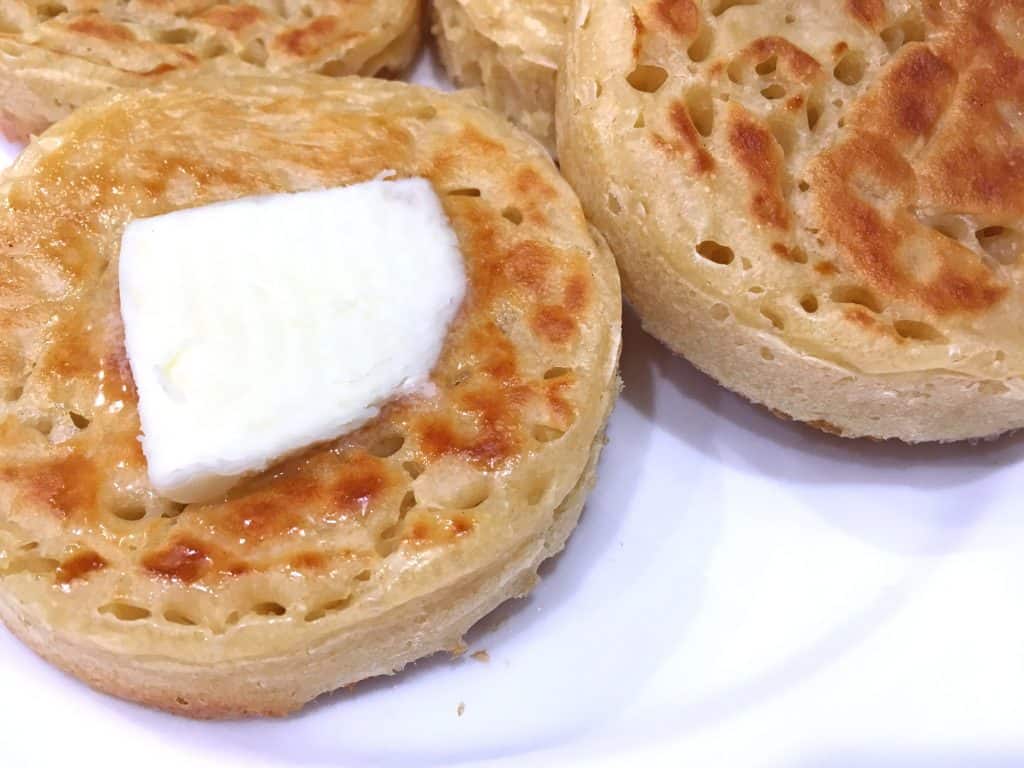
How to Make Crumpets
Crumpets are pretty straightforward to make and because they’re made with yeast they share some similarities with bread-making like:
- Making the batter (dough)
- Letting it “rise” (in the case of crumpet batter it will get puffy and bubbly)
- “Baking” it (in this case cooking it on a griddle on in a skillet inside individual rings).
Before we get started there are a few important questions I frequently get asked that I want to address to help ensure that your crumpet-making experience is a success!
How Long Should Crumpet Batter Rest?
Different recipes recommend different times. The batter is ready after sitting for 30 minutes (crumpets in above pics were made after 30 min) but I have found that letting it rest a bit longer will give you an even higher rise and a lighter texture. In the pic below I let the batter sit for an additional 20 minutes. See the side-by-side pic for a comparison of height. Try both and see which you prefer. Both are excellent but I slightly prefer the higher rise for that lighter, airer texture.
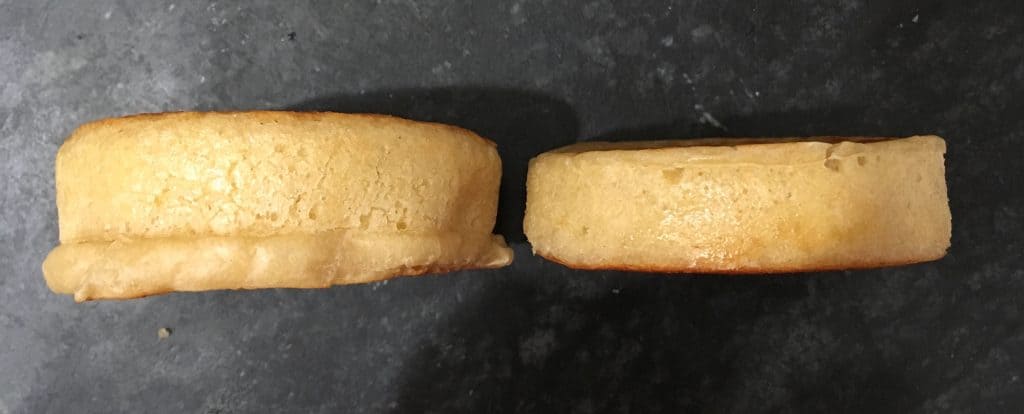
Equipment: Do I Need Crumpet Rings?
Yes. Crumpet batter is very loose and runny and the crumpets rings are what will shape and hold the batter while the crumpets are cooking.
I use Norpro’s English Muffin/Crumpet Rings. They do the job perfectly. Is there a substitute? Well, sort of. In a pinch I’ve had readers report success with using wide mouth jar canning bands but the bands have ridges which the batter will easily get stuck in, so just a heads up that it may result in frustration.
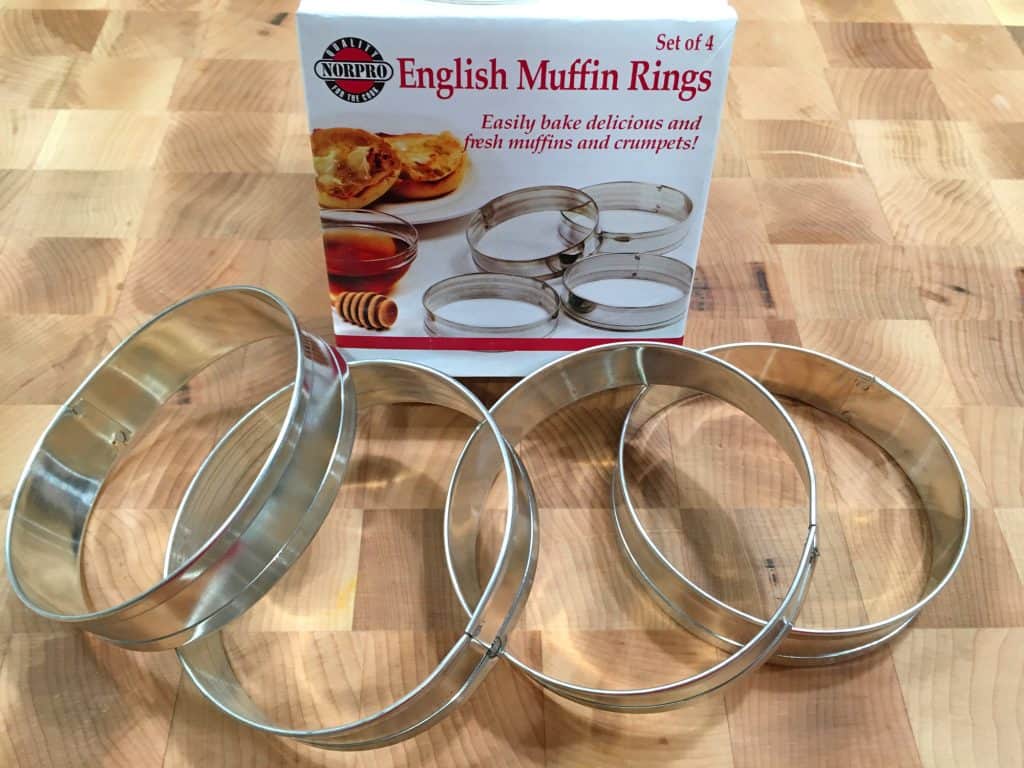
Crumpets Recipe
Let’s get started!
Stir the sugar and yeast into the warm milk and let it rest for 10 minutes until frothy. In a large mixing bowl or the bowl of a stand mixer combine the flour and salt.
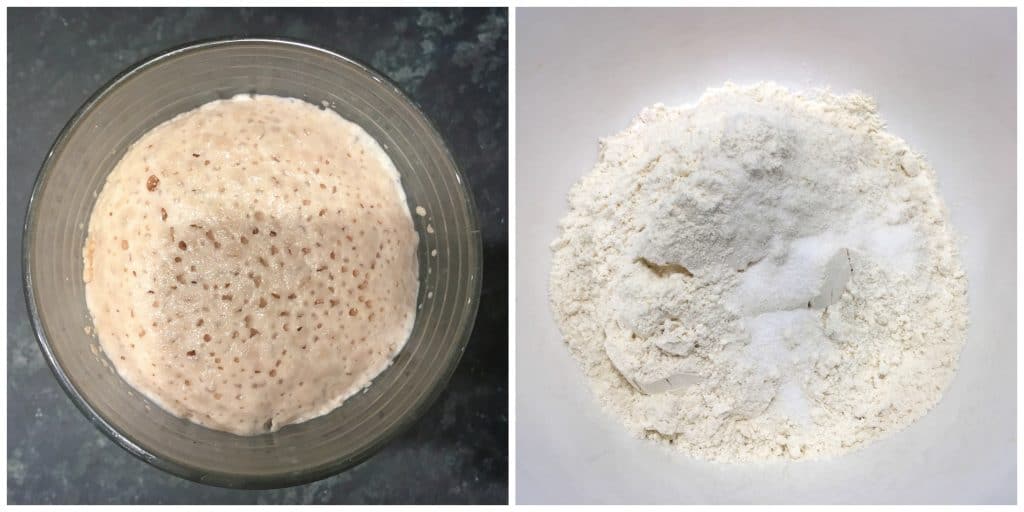
Add the liquid to the flour mixture and stir/knead until a thick dough forms. If using a stand mixer, use the paddle attachment and beat the mixture for about 3 minutes until a thick dough forms.
Cover the bowl loosely with plastic wrap and set it in a warm place to rise for at least an hour or up to two (it should nearly double in size). This stage is important for the formation of the bubbles that will later form the classic holes in the crumpets.
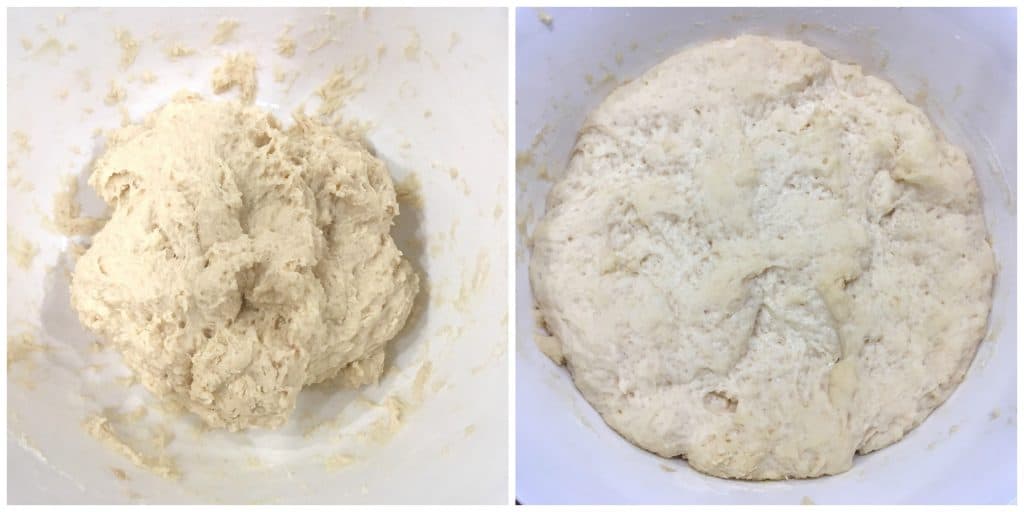
Dissolve the baking soda in the warm water and add it to the dough. In addition to the previous proving phase, the baking soda is also what helps aerate the crumpets to give them their classic pores. Those pores allow the butter later on to soak beautifully into the crumpet and gives them their famous sponge-like texture.
If using a stand mixer, beat the batter for a minute or two. Or use an electric mixer to beat the batter. If some small lumps remain that’s okay. Any remaining lumps will dissolve during the next resting stage.
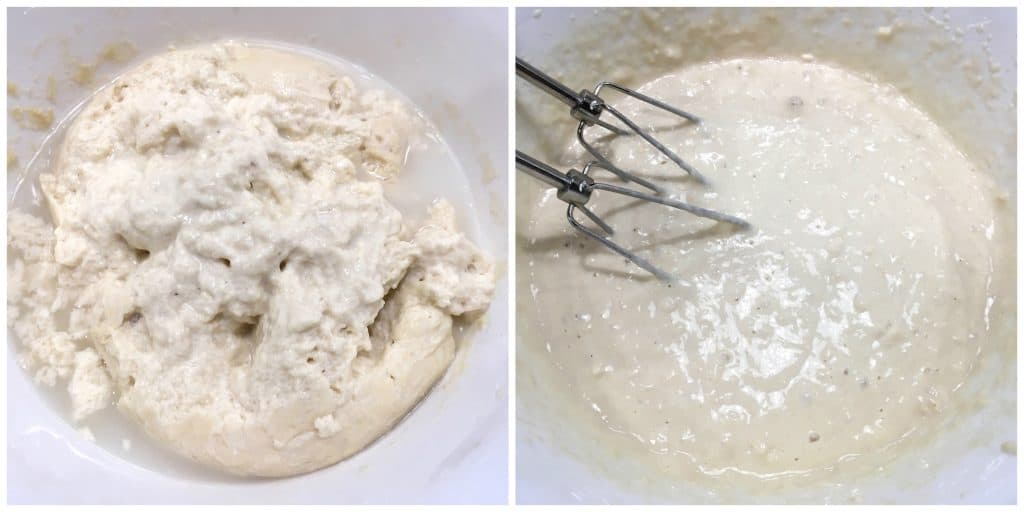
Cover the batter and let it rest in a warm place for at least 30 minutes (see note below comparing the rise of the crumpets depending on how long the batter sits).
After 30 minutes the batter should be nice and bubbly. When you stir it, it will bubble and froth nicely.
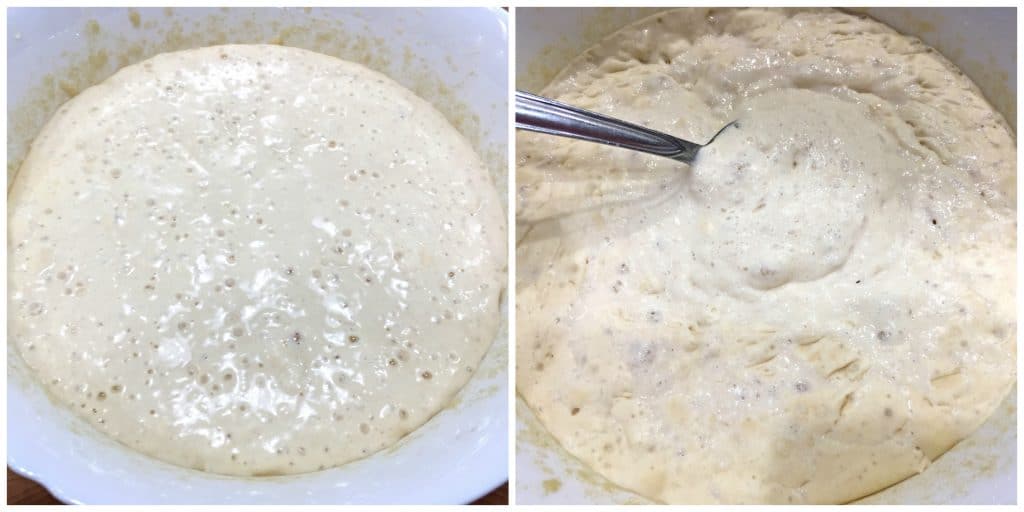
Prepare the crumpet rings: Oil the inside rims of the crumpet rings. Lightly oil the frying pan. You can use a regular skillet or a cast iron pan (my preference). I’m using my Lodge 12″ Cast Iron Pan.
Heat the pan and rings over medium-high heat. Once the rings are hot, pour the batter into each ring until it’s slightly more than half full.
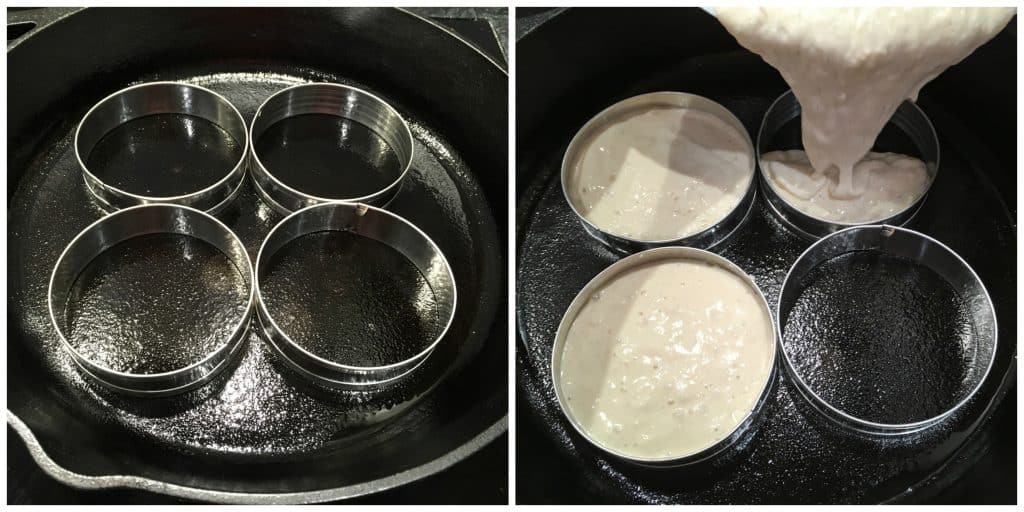
Cooking time will vary depending on your stovetop and frying pan but these will cook for approx 8-10 minutes (the time will vary according to the kind of cooktop and cookware you’re using. Just be sure to keep an eye on them to ensure they don’t burn on the bottom. Lower the temp as needed to finish off the cooking).
The batter will begin to rise and bubble on top.
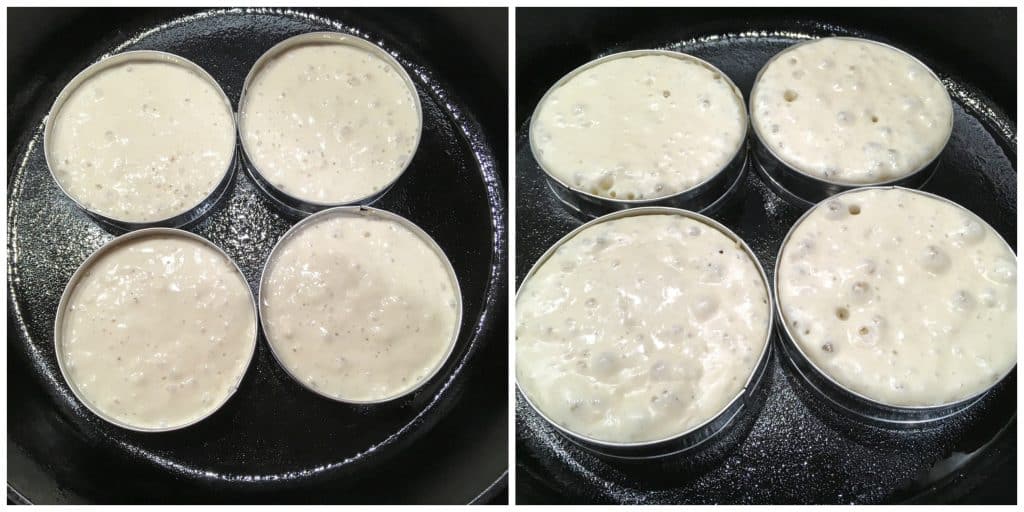
After several minutes when the tops are cooked and the classic pores/holes are present with the bottoms lightly browned, your crumpets are done and you can remove the rings.
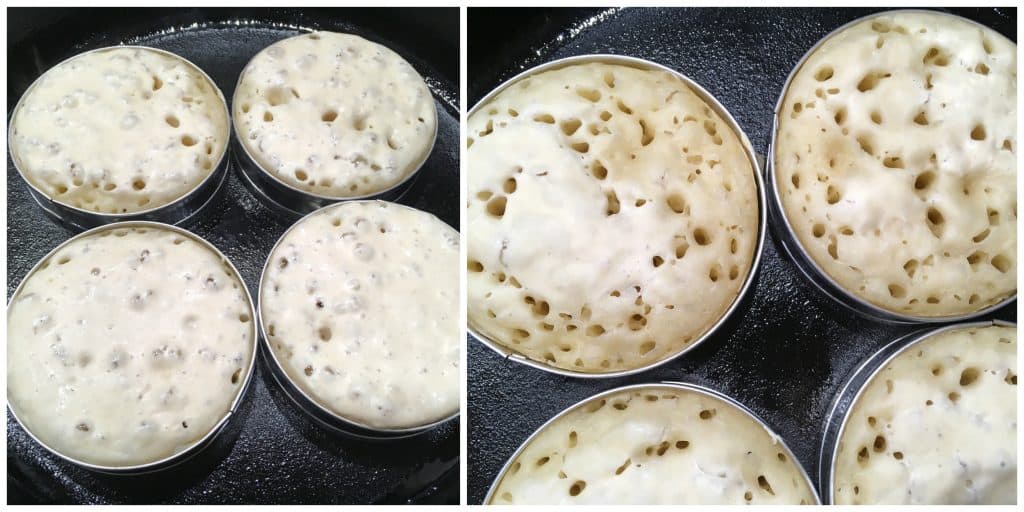
Traditionally crumpets are only cooked on one side only, not flipped over, and then toasted later. However, if you’re going to eat the crumpets immediately, I prefer to remove the rings and flip the crumpets over to cook an extra minute or two on the top side for a nice golden color and added layer of crispiness. If you flip them be careful not to move them so you don’t smear any uncooked batter and thereby cover over the pores.
If you’re keeping them for later or plan on freezing them, you have the option to flip or not flip – either way you’ll want to toast them to reheat them.
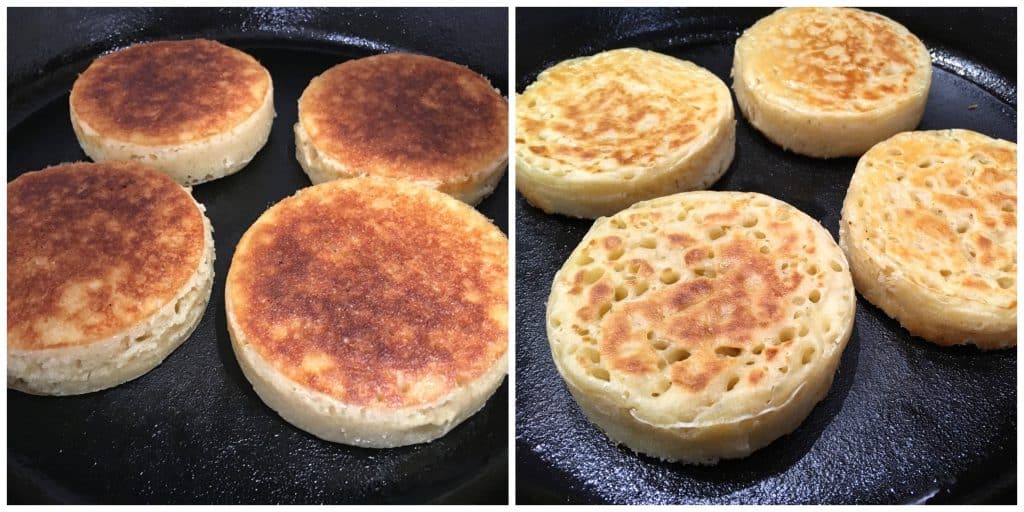
Your gorgeous, delicious homemade crumpets are ready to eat!
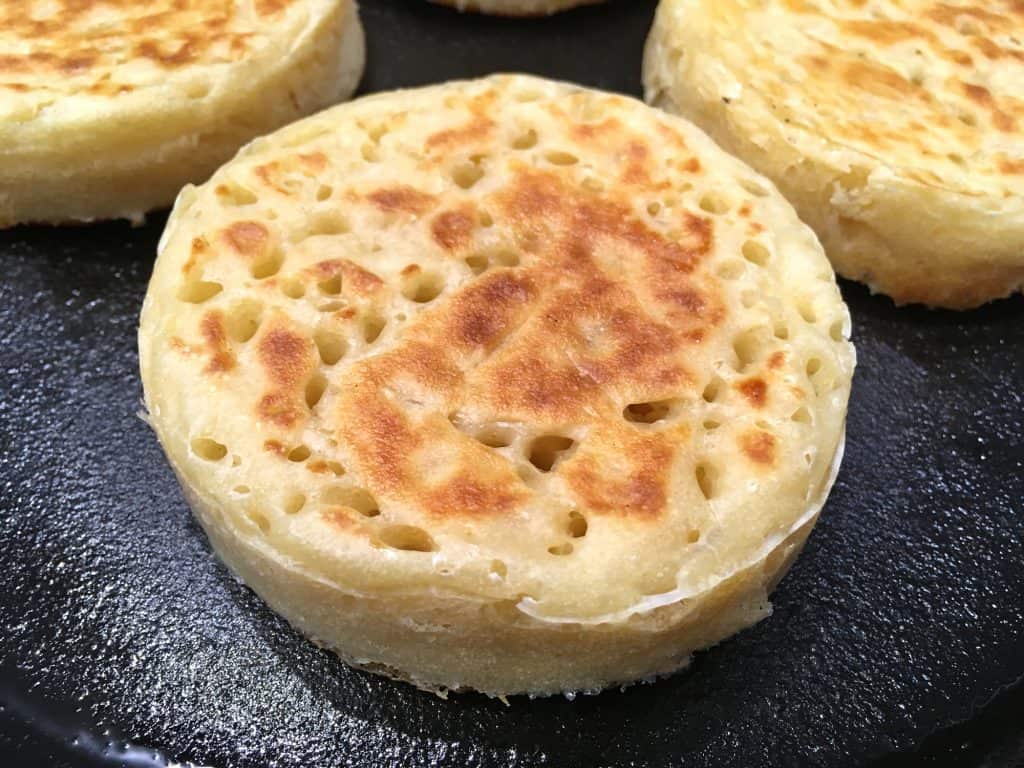
How to Eat Crumpets
Store-bought crumpets are always toasted before eating them because they’ve become soft from sitting in the packaging. However homemade crumpets straight out of the frying pan will be wonderfully crispy on the outside so there is no need to toast them. If you’re not serving them immediately toast them just before serving. Note: Crumpets are eaten whole/open-faced and are not cut in half horizontally.
Serve the crumpets warm slathered with butter, jam, golden syrup, honey or topping of your choice. Check out my recipes for homemade Black Currant Jam, Strawberry Rhubarb Jam, Gooseberry Jam, Blackberry Jam, Plum Jam, Lemon Lime Marmalade and Lemon Curd.
Storage and Freezing
Store the crumpets in an airtight container in the fridge where they will keep for 4-5 days. They also freeze well for up to 3 months. To freeze them, let them cool completely, place them in a ziplock freezer bag or freezer safe container, and put them in the freezer. When you’re ready to eat them, let them thaw on the counter, in the microwave, or in the fridge overnight and then toast them.

Enjoy!
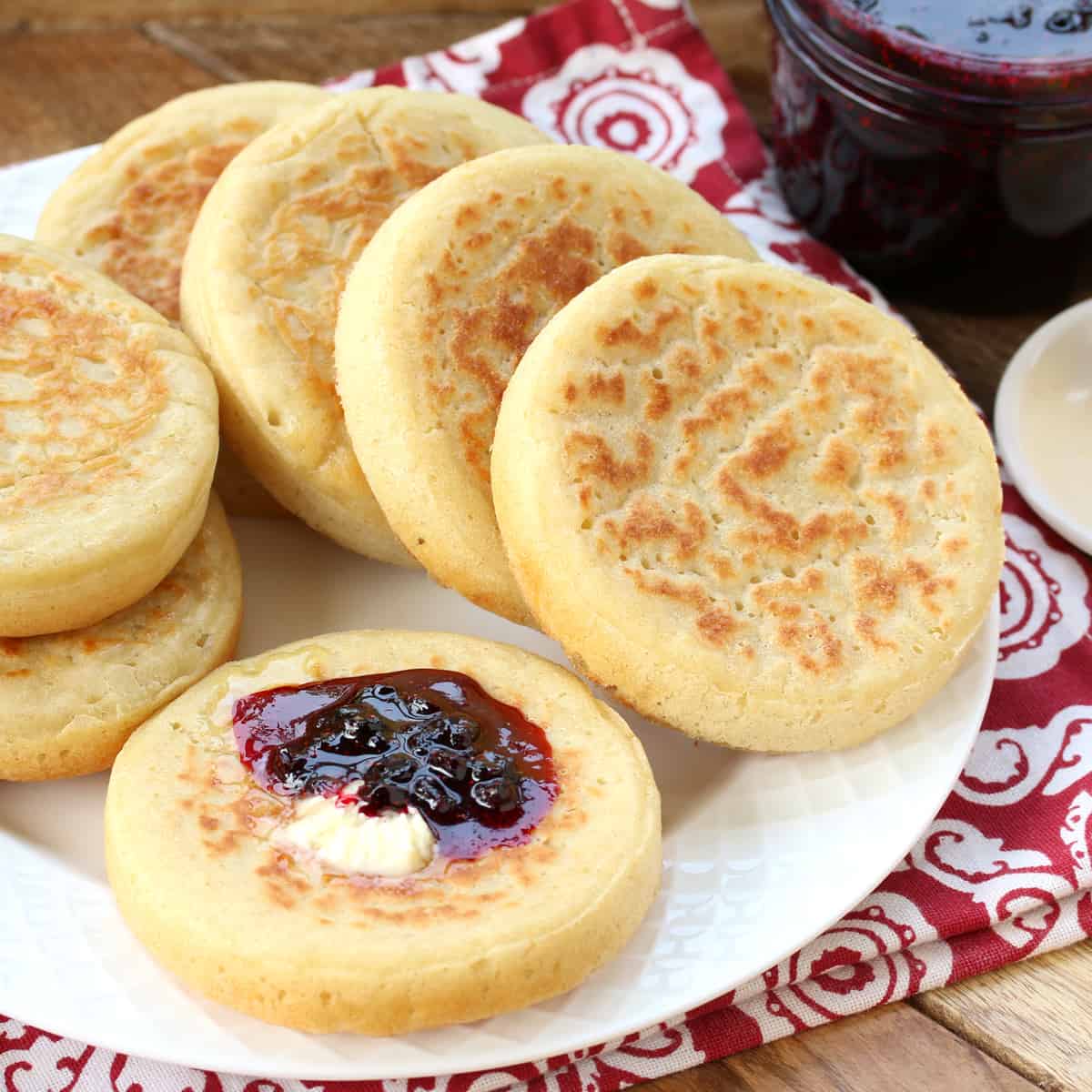
For more classic British recipes be sure to try my:
- Yorkshire Pudding
- Fish and Chips
- Mushy Peas
- Bangers and Mash
- Scotch Eggs
- Sticky Toffee Pudding
- Chelsea Buns
- Cornish Fairings
- Treacle Tart
- Lardy Cake
- Hot Cross Buns
- Eccles Cakes
- Spotted Dick
- Figgy Pudding
- Flapjacks
- Toad in the Hole
Save This Recipe
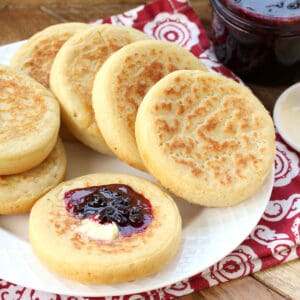
Traditional English Crumpets
Ingredients
- 2 cups all-purpose flour (can substitute half bread flour)
- 1 teaspoon salt
- 1 cup warm milk
- 2 teaspoons active dry yeast
- 1 teaspoon cane sugar
- 1 cup warm water
- 1/2 teaspoon baking soda
Instructions
- Stir the sugar and yeast into the warm milk and let it rest for 10 minutes until frothy. In a large mixing bowl or the bowl of a stand mixer combine the flour and salt.
- Add the liquid to the flour mixture and stir/knead until a thick dough forms. If using a stand mixer, use the paddle attachment and beat the mixture for about 3 minutes until a thick dough forms. Cover the bowl loosely with plastic wrap and set it in a warm place for at least an hour or up to two to let the dough rise (it should nearly double in size). This stage is important for the formation of the bubbles that will later form the classic holes in the crumpets.
- Dissolve the baking soda in the warm water and add it to the dough. If using a stand mixer, beat the batter for a minute or two. Or use an electric mixer to beat the batter. If some small lumps remain that’s okay. Any remaining lumps will dissolve during the next resting stage.Cover the batter and let it rest in a warm place for at least 30 minutes (see note below). After 30 minutes the batter should be nice and bubbly.
- Prepare the crumpet rings by greasing the inside of each rim. (I use and like Norpro's English Muffin/Crumpet Rings.) Lightly oil the frying pan. You can use a regular skillet or a cast iron pan (my preference). I use my Lodge 12" Cast Iron Pan.Place the rings in the frying pan over medium-high heat.
- Once the rings are hot, pour the batter into each ring until it's slightly more than half full. Cooking time will vary depending on your stovetop and frying pan but these will cook for approx. 10 minutes (**the time will vary according to the kind of cooktop and cookware you're using and may take longer. Just be sure to keep an eye on them to ensure they don't burn on the bottom. Lower the temp as needed to finish off the cooking). Turn the heat down as needed to prevent burning. The batter will begin to rise and bubble on top. After several minutes when the tops are cooked and the classic pores/holes are present with the bottoms lightly browned, your crumpets are done. Note: You can either remove the rings and flip the crumpets over to cook the other side for another minute or two until golden or remove them from the rings and toast the crumpets. (See blog post for more info on this.)
- Serve the crumpets immediately slathered with butter, jam, golden syrup or honey. To reheat later toast them in the toaster. Can also be frozen, thaw first before toasting. (Crumpets are eaten whole/open-faced and are not sliced in half horizontally.)
- NOTE: Regarding how long to let the batter sit before using: It’s ready after 30 minutes but letting it rest a bit longer will give you an even higher rise and a lighter texture (see blog post for side-by-side comparison pics). And more bubbles means more of those classic holes in your crumpets. Try both and see which you prefer. Both are excellent.
Video
Nutrition
Originally published on The Daring Gourmet October 17, 2019



















Don’t expect to whip these up for breakfast, but follow the instructions and I use my bread machine for the mixing and waiting steps and the crumpets as cooked turn out fantastically. Only half fill the crumpet rings as the crumpets rise spectacularl and are so much better than the thin, shop bought ones. I use wholemeal flour.
I’m so glad you enjoyed them, Mike, thank you for the feedback!
Not a single response above is from someone who actually made the recipe.
Personally, I’m not interested in the fact that you will make them some time in the future or that it looks delicious. It’s a recipe! How Was The Recipe?? Ugh!
Why don’t you make it and find out. Ugh!
“I wondered why, of all things, crumpets had earned such a prominent place on the British table.”
All British food is flavorless.
Give these homemade ones a try, qwerty, and I’m confident you’ll change your mind!
You obviously haven’t eaten british food, or you wouldn’t have made such an uneducated statement
This recipe was PERFECT! We’d tried another years ago and it failed miserably. We’d resigned ourselves to only getting a good crumpet overseas. So much for that!
Fantastic, Josh, thank you so much! :)
Brings back memories of toastiwerng bread and crumpets in front of my grannies fire. Those were the days of coal fires, very hot,very compact and of course she had an array of toasting forks. Long handled with 3 or 4 prongs. If you weren’t careful you could definally get a fire crumpet!!! I’m going to try your recipe for sure, but I’ll stick to my toaster if I need to toast any.Thank you wholeheartedly for both the recipes and the memories.
Who knows, they may taste great, but if you put them on medium high heat for 10 minutes, you’re going to burn them. Wasted all that time. Preparing the batter, only to have them burn on the bottom, and I didn’t even have it on medium high. I had it on less than the halfway setting. More like turn to medium low after dropping in at medium for a minute or two. So frustrating.
Excellent recipe, great for making on a Sunday as it takes a while between steps but sooo worth it! Slathered with margarine and fig jam and of course a spot of tea ☕️!
So wonderful, Jen, I’m thrilled you enjoyed them, thank you!
What would happen if I use 2% fat instead of whole milk/ full fat milk for this recipe? Thanks.
Hi Linda, that’s totally fine. Happy crumpet making! :)
Thanks Kimberly! My attempt was disastrous – none edible. I couldn’t get the yeast to activate. I tried three times, including running out and buying a new packet of Active Dry Yeast (I measured 2 teaspoons out of the packet which contains 2-1/4 teaspoons). I used a thermometer to ensure the full fat warm milk was 100-110F. All within expiry dates, so all ingredients were fresh. No froth, foam, bubbles…just flat whole milk which I proceeded to use.
The dough did rise but no bubbles even after the baking soda/ water. I don’t have a cast iron pan so used a pancake griddle and crumpet rings. Maybe about 10-12 bubbles per crumpet, bottoms burnt, inside gooey-dense-raw.
sob sob sob :0(
How’s everyone finding it so easy?
Did you add the sugar to the yeast and warm milk? You might also want to try quick rising yeast.
My mom is English but we live in the US, so she misses being able to easily buy crumpets. I made these for her today and they were amazing! The texture of the first crumpets wasn’t very hole-y, but they tasted just right. I cooked the last crumpet at a higher temperature and ignored any smoking and it was perfect with loads of holes. I can’t wait to make these again!
I’m so glad, Abigail, thanks so much for the feedback! :)
Can crumpets from this recipe be frozen?
Yes they can, Karen. Then simply thaw and toast them.
I doubled the recipe and wasn’t disappointed. Beautiful texture and crispness as well as being fluffy and chewy. I’ll be sharing these with a crumpet loving friend. I opted for half all purpose flour and half bread flour. I doubled up on the yeast as well because it was past it’s BB date but I am wondering if I would need to double up with fresher yeast? Will have to experiment next time with whole wheat flour in place of the all purpose. This is now my go to recipe for crumpets.
Thank you, June, I’m so glad you enjoyed them! No, there’s no need to double up on the yeast if what you’re using is fresh. Thanks again for the feedback!
I made these this eve… a great start to a good recipe but way too much yeast. They taste fermented… Almost like rice wine vinegar… I make a killer pizza dough that has more than double the flour with only a fraction of the yeast and it rises like that last day on earth.
I made these today and it was my first time making crumpets. I am really happy with how they turned out. I did the first rise for 2 hours and the second for 30 minutes. Next time I think I’ll cut back on the yeast – 1 tbs made them delightfully airy but the flavour of the yeast was too strong once they were cooked. The texture was fantastic, and I’m grateful that you shared this recipe! I also used a cast iron pan. The longer you have the pan over the heat the more heat it retains so I had to turn it down a lot. I also used cold butter in the pan to help bring the temperature down a little between batches. I ended up with 10 crumpets from this recipe, two were eaten right away with butter and maple syrup and the other 8 have been frozen for breakfasts/snacks for this coming week. Really happy with them!
I’m so glad you enjoyed them, Louie, thank you for the feedback!
Followed the recipe exactly and they turned out delicious, however, the insides were raw. The only difference is that I didn’t use a cast iron pan (don’t have one).
They had set and dried completely on top (like pancakes) and I flipped them over to get them golden on the other side but when I took them off the heat and cut into one, it was completely mushy and doughy inside.
When cooking anything, if the outsides are cooked to the right amount, or even overcooked, but the inside is still undercooked, what you want to do is cook it at a lower temperature for a longer period of time. If you are cooking at too high a temperature, the outsides are basically cooking too quickly, not leaving enough time for the heat to travel into the centre of the food to cook it. On the other hand, as long as the bottom isn’t burnt, you might just need to cook it for longer at the same heat before flipping. The bottoms of crumpets tend to be pretty heavily cooked and darkened (not burnt but pretty dark).
Best crumpet recipe ever have made these many times simply the most authentic tasting. I always double the ingredients and make enough to share or freeze.
Thank you so much, Peter, I’m happy you enjoyed it and appreciate the feedback!